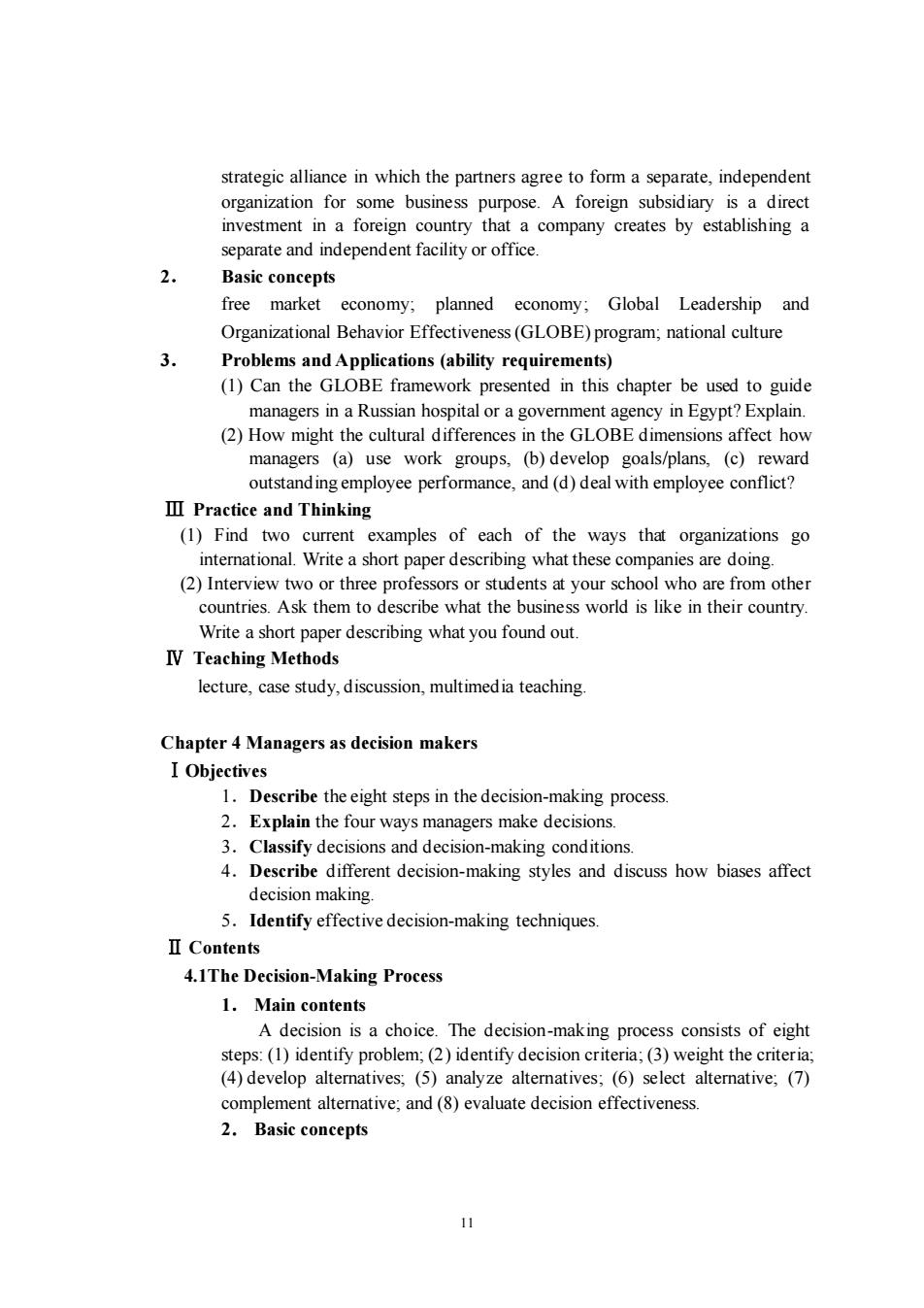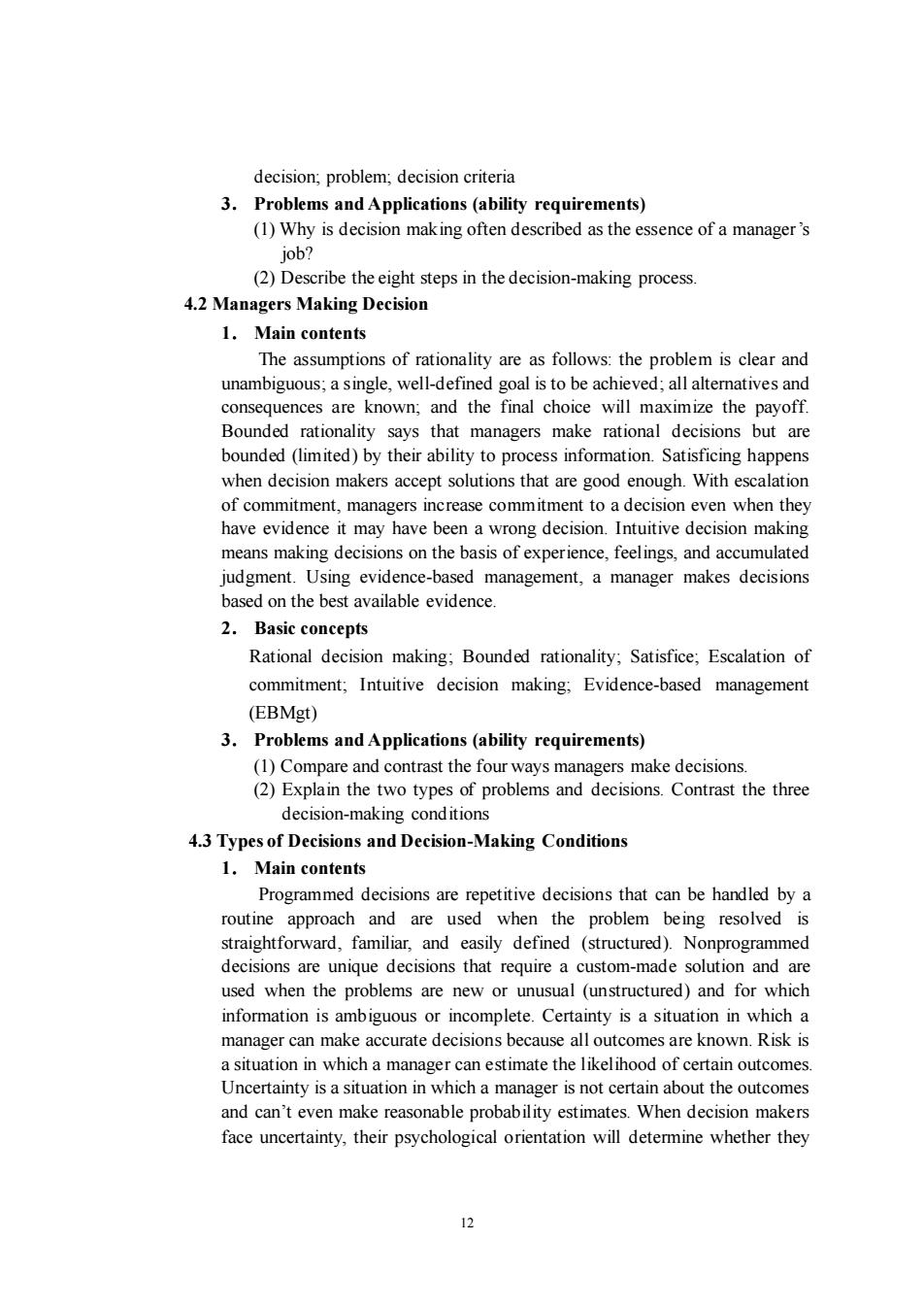
strategic alliance in which the partners agree to form a separate,independent organization for some business purpose a foreign subsidiary is a direct investment in a foreign country that a company creates by establish ing separate and ir ndependent facility or office 2. Basic concepts free market economy:planned economy;Global Leadership and Organizational Behavior Effectiveness(GLOBE)program;national culture 3. Problems and Applications(ability requirements) (1)Can the GLOBE framework presented in this chapter be used to guide managers in a Russian hospital or a government agency in Egypt?Explain. (2)How might the cultural differences in the GLOBE dimensions affect how managers (a)use work groups.(b)develop goals/plans,(c)reward outstanding employee performance,and(d)de h employee conflict? III Practice and Thinking (1)Find two current examples of each of the ways that organizations go ntemational.er dese g what the nie s are doing wo or three profe or st your scho are from other countries.Ask them to describe what the business world is like in their country. Write a short paper describing what you found out. IV Teaching Methods lecture.case study.discussion.multimed ia teaching Chapter 4 Managers as decision makers I Objectives 1.Describe the eight steps in the decision-making process 2.Explain the four ways managers make decisions. 3.Classify decisions and decision-making conditions 4.Describe nt decision-making styles and discuss how biases affect decision making. 5.Identify effective decision-making techniques. II Contents 4.1The Decision-Making Process 1.Main contents A decision is a choice.The decision-making process consists of eight steps:(1)identify problem;(2)identify decision criteria;(3)weight the criteria; (4)develop alternatives:(5)analyze alternatives:(6)select alternative:(7) omplement altemative:and (8)evaluate decision effectiveness. 2.Basie concepts
11 strategic alliance in which the partners agree to form a separate, independent organization for some business purpose. A foreign subsidiary is a direct investment in a foreign country that a company creates by establishing a separate and independent facility or office. 2. Basic concepts free market economy; planned economy; Global Leadership and Organizational Behavior Effectiveness (GLOBE) program; national culture 3. Problems and Applications (ability requirements) (1) Can the GLOBE framework presented in this chapter be used to guide managers in a Russian hospital or a government agency in Egypt? Explain. (2) How might the cultural differences in the GLOBE dimensions affect how managers (a) use work groups, (b) develop goals/plans, (c) reward outstanding employee performance, and (d) deal with employee conflict? Ⅲ Practice and Thinking (1) Find two current examples of each of the ways that organizations go international. Write a short paper describing what these companies are doing. (2) Interview two or three professors or students at your school who are from other countries. Ask them to describe what the business world is like in their country. Write a short paper describing what you found out. Ⅳ Teaching Methods lecture, case study, discussion, multimedia teaching. Chapter 4 Managers as decision makers ⅠObjectives 1.Describe the eight steps in the decision-making process. 2.Explain the four ways managers make decisions. 3.Classify decisions and decision-making conditions. 4.Describe different decision-making styles and discuss how biases affect decision making. 5.Identify effective decision-making techniques. Ⅱ Contents 4.1The Decision-Making Process 1. Main contents A decision is a choice. The decision-making process consists of eight steps: (1) identify problem; (2) identify decision criteria; (3) weight the criteria; (4) develop alternatives; (5) analyze alternatives; (6) select alternative; (7) complement alternative; and (8) evaluate decision effectiveness. 2. Basic concepts

decision:problem:decision criteria 3.Problems and Applications(ability requirements) (1)Why is decision making often described as the essence of a manager's (2)Describe the eight steps in the decision-making process 4.2 Managers Making Decision 1.Main contents The assumptions of rationality are as follows:the problem is clear and ngle,well-defined is to be altematives ar consequence e will ma the payoff Bounded rationality says that managers make rational decisions but are bounded (limited)by their ability to process information.Satisficing happens when decision makers accept solutions that are good enough.with escalation of commitment. nt to a decisi even when the have evide may have be cen a wro n means making decisions on the basis of experience,feelings,and accumulated judgment.Using evidence-based management,a manager makes decisions based on the best available evidence. 2.Basic concepts Rational decision making;Bounded rationality;Satisfice;Escalation of commitment:Intuitive decision making:Evidence-based management (EBMgt) 3. Problems and Applications(ability requirements) (1)Compare and contrast the four ways managers make decisions. (2)Explain the two types of problems and decisions.Contrast the three decision-making conditions 4.3 Types of Decisions and Decision-Making Conditions 1.Main contents Programmed decisions are repetitive decisions that can be handled by a routine approach and are used when the problem being resolved is straightforward,familiar,and easily defined (structured).Nonprogrammed decisions are unique decisions that require a custom-made solution and are used when the problems are new or unusual (unstructured)and for which ambiguous nty is a situation in which a manager can make accurate decisions because all outcomes are known.Risk is a situation in which a manager can estimate the likelihood of certain outcomes. Uncertainty is a situation in which a manager is not certain about the outcomes and can't even make reasonable probability estimates.When decision makers face uncertainty,their psychological orientation will determine whether they 12
12 decision; problem; decision criteria 3. Problems and Applications (ability requirements) (1) Why is decision making often described as the essence of a manager’s job? (2) Describe the eight steps in the decision-making process. 4.2 Managers Making Decision 1. Main contents The assumptions of rationality are as follows: the problem is clear and unambiguous; a single, well-defined goal is to be achieved; all alternatives and consequences are known; and the final choice will maximize the payoff. Bounded rationality says that managers make rational decisions but are bounded (limited) by their ability to process information. Satisficing happens when decision makers accept solutions that are good enough. With escalation of commitment, managers increase commitment to a decision even when they have evidence it may have been a wrong decision. Intuitive decision making means making decisions on the basis of experience, feelings, and accumulated judgment. Using evidence-based management, a manager makes decisions based on the best available evidence. 2. Basic concepts Rational decision making; Bounded rationality; Satisfice; Escalation of commitment; Intuitive decision making; Evidence-based management (EBMgt) 3. Problems and Applications (ability requirements) (1) Compare and contrast the four ways managers make decisions. (2) Explain the two types of problems and decisions. Contrast the three decision-making conditions 4.3 Types of Decisions and Decision-Making Conditions 1. Main contents Programmed decisions are repetitive decisions that can be handled by a routine approach and are used when the problem being resolved is straightforward, familiar, and easily defined (structured). Nonprogrammed decisions are unique decisions that require a custom-made solution and are used when the problems are new or unusual (unstructured) and for which information is ambiguous or incomplete. Certainty is a situation in which a manager can make accurate decisions because all outcomes are known. Risk is a situation in which a manager can estimate the likelihood of certain outcomes. Uncertainty is a situation in which a manager is not certain about the outcomes and can’t even make reasonable probability estimates. When decision makers face uncertainty, their psychological orientation will determine whether they